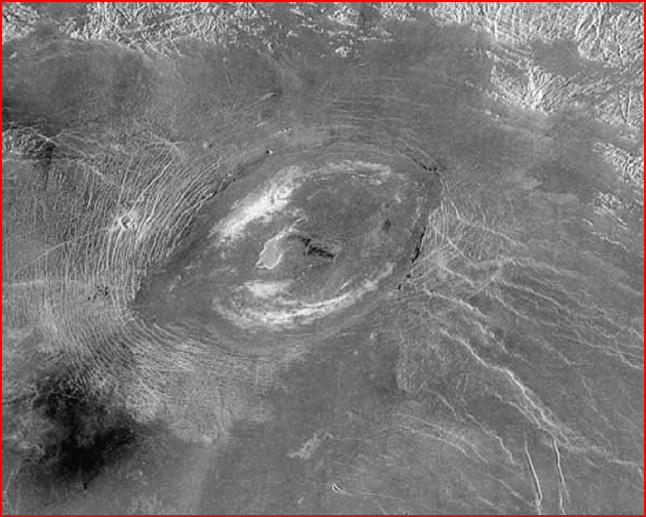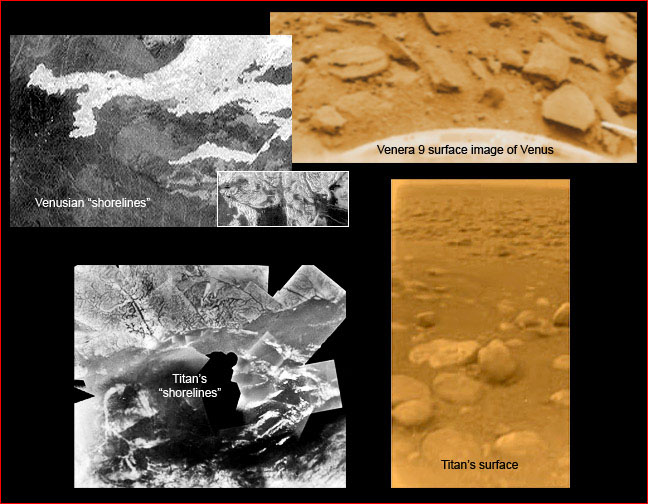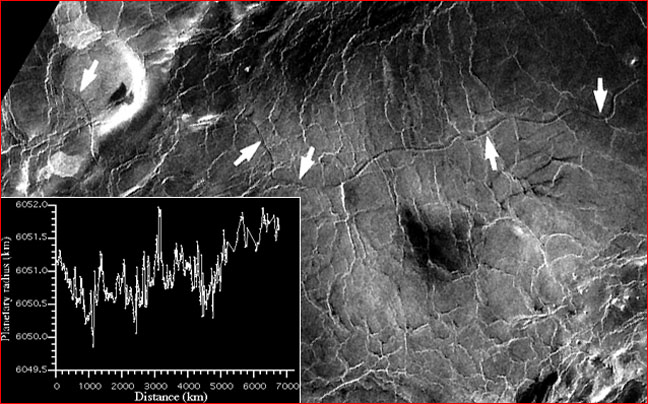


Rough Notes:
 Credit: top: Venus: NASA, JPL, Magellan; bottom: Sandia National laboratory |
||
|
pic of the day Links: Society for
|
Oct 20, 2004 In the common gravitational models of solar system evolution, little has happened to planetary orbits across the eons. This belief persists even though gravitational theory indicates that more than two bodies orbiting in a system are unstable and subject to wild motions. But in the electric model of the solar system, orbital instabilities are damped by the exchange of electrical energy between planets. Before gravitational instabilities can evolve so far as to cause collisions, electrical interactions will redistribute energies to keep orbits apart. Today the electric exchanges are almost unnoticeable: the "blue clearing" of Mars' atmosphere at opposition (when Earth is between Mars and the Sun) may be the effect of the Earth's electrified plasma tail brushing across that planet; the detection near Earth of the Birkeland current "strings" in the Venusian cometary tail at inferior conjunction (when Venus is between the Earth and Sun) is another example. But if planets moved more closely in the past the electrical effects would have been much more severe. Do we have evidence of more powerful electrical exchanges in the past? The picture above, showing the equatorial region of the planet Venus, reveals one predictable effect of interplanetary electrical exchanges. This spidery network of "arachnoids" on the Venusian surface was completely unexpected. Higher resolution images reveal an even more extraordinary filamentary structure. Space scientists have called the formations "weird". No geologic process observed today produces such formations. But lightning, an electrical process, DOES produce them. An electrical arc striking a low-conductivity surface will scavenge electrons from great distances and carve branching channels called Lichtenberg figures. The lower picture shows a discharge produced by Sandia National Laboratories' "Z" machine. The machine has an input power of about 290 trillion watts for billionths of a second, and in that instant it consumes the equivalent of about 80 times the rest of the world's output of electricity. In the photograph a spider's web of electric discharge (a Lichtenberg figure) illuminates the Z-machine's surface. A similar discharge structure would occur at a planetary level. In the laboratory the discharge is recorded in billionths of a second, but scaled up to cosmic dimensions, the discharge could last for years. Also, filamentation of the discharge increases with atmospheric pressure. Because Venus has an extremely high-pressure atmosphere, 90 times that of Earth, the extraordinary filamentation of the arachnoids is to be expected. In the electric model, if two planets approach each other and their "magnetospheres" (Langmuir Sheaths, which limit the reach of a planet's electric field) make contact, the connection of planetary electric fields may produce intense discharging. To visualize the effects, one must scale up plasma laboratory discharge to planetary dimensions. For someone standing on one of the planets, the approaching body would take on the appearance of a planet-sized storm cloud in the sky. The "thunderbolts of the gods" forged in the encounter would make even the most powerful lightning today seem as little more than a spark from a hairbrush. |
|
|
Copyright 2004: thunderbolts.info |
||

Sacajawea Patera, Venus. Credit: NASA/JPL Magellan Mission
Nov 30, 2007
Aphrodite's Blazing Mane
Lightning bolts have "unexpectedly" been discovered arcing through the atmosphere of Venus. Electric Universe advocates predicted such activity long ago.A recent announcement by the European Space Agency (ESA) has called attention to the "surprising" electrical activity taking place on the planet Venus. Electric discharges were detected in the planet's upper atmosphere by the Venus Express orbiter that has been circling the cloud-shrouded orb since April 11, 2006. The discovery was completely unexpected because, until now, the density of the Venusian atmosphere was thought to prevent the formation of lightning bolts.
According to Dr. Donald Gurnett, a physicist at the University of Iowa and a member of the Cassini-Huygens mission team:
"If lightning exists in the Venusian atmosphere, it is either extremely rare, or very different from terrestrial lightning. If terrestrial-like lightning were occurring in the atmosphere of Venus within the region viewed by Cassini, it would have been easily detectable."
The Cassini spacecraft circled Venus on its way to explore the Saturnian system. In order to save fuel, NASA engineers sent Cassini on a trajectory that flew it twice around Venus so that it could receive a "gravity assist" from the planet. During those flybys, Cassini monitored the cloud tops and found no evidence that Earth-like lightning was taking place.
However, the mission specialists did realize that the discharges on Venus could be of a lower frequency than lightning on our planet because radio signals cannot penetrate the ionosphere at frequencies below one megahertz. Therefore, they were unable to make a definitive statement about plasma discharges.
Now, Venus Express has found low-frequency EMR that appears in bursts lasting fractions of a second. Called "whistlers", the bursts are considered a sure sign of electric discharges. A whistler is an extremely low-frequency electro-acoustic wave that is normally generated by lightning. They are called "whistlers" because they demonstrate a characteristically decreasing frequency falloff in detection equipment. In some short-wave radio transmissions, the whistle can be heard while tuning between stations.
With the detection of "whistlers", scientists can now make that definitive statement:
"We consider this to be the first definitive evidence of abundant lightning on Venus," said David Grinspoon from the Denver Museum of Nature and Science.
In a previous Thunderbolts Picture of the Day, we noted that the optical spectrum of Venus resembles that of a gas discharge tube similar to a neon lamp. Astrophysicists are unable to explain the contradictions that inevitably result when trying to explain the data based on greenhouses and smog, but the electrical explanation covers all the bases. Indeed, the atmospheric composition of Venus seems to require the presence of intense lightning in order to form the sulfurous compounds that are present. No chemistry on Earth or Venus can explain the depth and density of the sulfuric acid clouds and abundant carbon dioxide.
Venus radiates in the infrared with twice the energy it receives from the sun, so there must be a source for that heat. Venus has an extremely weak magnetic field and no magnetosphere but it does possess an ionosphere, so it is an electrically charged body. The ionosphere is prickly with Birkeland currents that carry electricity from the "solar wind" (actually a stream of ions ejected by the sun's electromagnetic field) into the Venusian environment. With so muchelectrical energy pumping into it, it may be that the planet is constantly charging and discharging with an infrared glow.
Birkeland currents act as transmission lines moving energy from the sun and planets over the entire solar system and ultimately, throughout interstellar space. Venus is not really separate from the sun, but acts as an element in the vast electrical circuit that powers the stars. Plasma discharges in that scenario are not so "unexpected".
In the image at the top of the page, many examples of electric discharge machining can be seen. The crater rim is elongated and clearly shows the marks of multiple rings. There are sinuous rilles in the surrounding terrain much like those on Mars, the Moon, Europa and other celestial bodies. We have theorized many times in these pages that such formations are the result of tremendous lightning bolts that seared them into the surface like a plasma torch.
Because of the observational data and the ideas put forth by such luminaries as Langmuir and Alfven, lightning on Venus was both expected and predicted by Electric Universe theorists.
By Stephen Smith
 Caption: [Left] A composite radar image of the western hemisphere surface of Venus. Image Credit: SSV, MIPL, Magellan Team, NASA. [Right] A low-resolution infrared image of Saturn’s moon, Titan. Image credit: ESO Titan |
||
|
pic of the day Links: Society for
|
Feb 01, 2005 One of the major surprises of the Cassini mission to Saturn was the discovery that Saturn’s enigmatic moon Titan seems to have no large craters. If the moon has been in existence for 4.7 billion years in the powerful gravitational well of Saturn, then the nebular hypothesis—assuming accretion of planets and moons by impacts—expected some large craters to dominate the surface relief. When none were found, scientists proposed that Titan had undergone some “resurfacing” process. It is interesting to note that the same ad hoc proposal was made when Venus was revealed to have a surprisingly youthful surface. But resurfacing is only required if Venus and Titan are assumed to be very old bodies. The Electric Universe model of planet formation identifies both Venus and Titan as newborn members of the solar system. It therefore considers both to be as youthful as their faces look. In the electric model, massive electrical discharge disfigures the faces of newborn planets and moons. On both Venus and Titan we see the filamented discharge patterns that are expected when arcing occurs through a heavy atmosphere. The planet-girdling, spidery channels on Venus, seen in the picture above, precisely match the patterns of filamentary “Lichtenberg” lightning scars. And on Titan, the first close-up images of its surface by the Huygens probe showed a network of Lichtenberg-like channels. We urge planetary scientists to examine these channels for the telltale signatures of electrical arcing. In particular we should expect the causative agent’s to have shown no regard for the rules of flowing liquid. And chains of craters running along the channels can be expected, though crater chains have no place in the standard interpretation of these channels. When it comes to Titan’s big sister Venus, planetary geology is strongly reinforced by the historical record, since the unusual appearance and behavior of Venus provoked many extraordinary and global traditions in the ancient cultures. In coming TPODS, therefore, we will examine the story of Venus from both scientific and historical vantage points. |
|
|
Copyright 2005: thunderbolts.info |
||
 Titan images: NASA/ ESA/ University of Arizona. Venus Magellan image: NASA/JPL |
||
|
pic of the day Links: Society for
|
Jan 19, 2005 Australian physicist Wallace Thornhill predicted many of the recently discovered surprising features of Saturn's moon, Titan. In June last year he claimed that: "the moon Titan, which is larger than the planet Mercury, seems to be a close sibling of Venus.. That Titan may be young is hinted at by its eccentric orbit, which cannot have persisted for billions of years. So we should be alert to similarities between Titan and Venus." See Cassini's Homecoming: http://www.holoscience.com/news.php?article=f16tg4w1 On December 28, 2004 Thornhill elaborated: "Under the electric hypothesis Titan was likely born by electrical expulsion from the proto-Saturnian brown dwarf. So it should be found to have features in common with Venus, the planet that shows the most abundant signs of geologically recent ejection. Already it is known that Titan has the heaviest atmosphere after its sister, Venus." His further claims were based on the behavior of electrical discharges in such a dense atmosphere: "Titan’s surface features should also be compared to those of Venus. Scientists tell us that Titan seems to have been "resurfaced" because there is no evidence of the expected primordial cratering. The same thing was said about Venus! Also a radar return from Titan was 'of a type that we would expect to get back from Venus.' In the electrical hypothesis, the similarity would be expected--a heavy atmosphere tends to cause filamentation of cosmic electrical scars instead of large craters. Such scars encircle Venus’s equator in the form of rilles and spider-web-like formations called 'arachnoids'." See: http://www.thunderbolts.info/tpod/2004/arch/041228prediction-origins.htm These claims should be easy to falsify. But so far the electrical model is the only one to successfully predict what would be found by the Huygens probe. On today's TPOD we look at features imaged by the Huygens probe in its successful descent to the surface of Titan and compare them with images of Venus. At top left we see a radar image of the Venusian surface returned by the Magellan Orbiter. David Grinspoon, in his book, Venus Revealed,interpreted the dark areas in traditional "geocentric" terms: "The vast volcanic plains that cover nearly all low-lying areas are the long-sought global ‘oceans’ on the surface of Venus – frozen oceans of basalt. One of the most astounding surface forms discovered by Magellan furthers the analogy: this ocean is fed by rivers! We see numerous thin, meandering channels, typically a mile wide and up to thousands of miles in length. [The small inset to the Magellan image shows an example of the 'river' channels cut into the white areas.] On Earth or Mars we would interpret such features as evidence of past or present running water. The analogy goes quite deep.... We have had to use a lot of imaginative physics and chemistry to come up with a suitable model." Now similar features are being discovered on Titan [lower left image]. Traditional interpretations will again require "a lot of imaginative physics and chemistry." But the electrical scarring model applies simply to them all. The surface of Venus can be matched against the surface of Titan, feature for feature. The Huygens probe is believed to have come to rest in the dark area, or "sea," at the center of yesterday’s TPOD image. The surface of the "sea" is solid! At bottom right is the first image returned from Titan’s surface. For comparison, above it is an image of the Venusian surface returned by the Russian Venera 9 spacecraft. David Grinspoon again, referring to Venus: “The immediate impression, of an eroded field of volcanic rocks, has stood up under decades of scrutiny.... What would erode and transport fine-grained material on a planet with no water and almost no winds?” Emily Lakdawalla, The Planetary Society's Science and Technology Coordinator, had a similar “immediate impression” of the “eroded field” that Huygens imaged from the surface of Titan [lower right image]: "Any geologist worth her salt thinks of one thing and one thing only when she sees round rocks: some river of some liquid has rolled broken chunks around, wearing down their edges, making rounded cobbles. Or, as United States Geological Survey geologist Larry Soderblom remarked to me: 'We've got rolling stones!'" But there is another mechanism that creates strewn fields of eroded rocks on a vast scale. The process of planetary birth and subsequent electrical interactions during close encounters with other bodies, as orbits adapt to a new stable configuration, causes deposition of dust, stones and boulders arriving from space or blasted from distant parts of the same body. Plasma heating and etching, combined with "spark" generated "winds," are responsible for rounding the rocks, scattering them uniformly across the landscape, and leaving "flow streaks" from electrical "winds." The traditional erosional mechanisms of blowing gases and flowing liquids require action over long spans of time to achieve observed effects. Electrical erosion, resulting from the action of forces that can be billions of times stronger than mechanical forces, can achieve observed effects in short times. Similarity of features is not proof of identity of cause. Further empirical tests must be devised to distinguish among possible hypotheses. But this first test--the Huygens close-up observation of features--verifies the predictions of the electrical hypothesis and surprises, if not falsifies, traditional explanations. |
|
|
Copyright 2005: thunderbolts.info |
||
 Caption: This Magellan Orbiter image shows a section of the “River Styx” or Baltis Vallis sinuous “river” channel on Venus. Inset is a topographical chart of Baltis Vallis, showing that it rises and falls some 2 kilometers in elevation along its 6,800 km length. A liquid cannot have carved this channel. Inset credit: Profile of Baltis Vallis, the longest channel (from Komatsu and Baker, 1994). “Baltis” is a Syrian word for the planet Venus. |
||
|
pic of the day Links: Society for
|
Feb 03, 2005 In his book, Venus Revealed, David H. Grinspoon comments on the image above: “The vast volcanic plains that cover nearly all low-lying areas are the long-sought global ‘oceans’ on the surface of Venus–frozen oceans of basalt. One of the most astounding surface forms discovered by Magellanfurthers the analogy: this ocean is fed by rivers! We see numerous thin, meandering channels, typically a mile wide and thousands of miles in length. The longest of these, Baltis Vallis, winds more than forty-two hundred miles over the plains [and might have been longer originally]. Baltis is longer than the Nile and thus can safely be called the longest river anywhere within several light-years of here. On Earth or Mars we would interpret such features as evidence of past or present running water. The analogy with structures carved by terrestrial water goes quite deep. We see fanlike river deltas, meanders, and bars, and places where streams have flooded their banks. “…On Venus, where it is far too hot for liquid water, perhaps a stream of lava with the right chemical composition could flow like a river. We have had to use a lot of imaginative physics and chemistry to come up with a suitable model. “…Topographical analysis of the flow paths produced a puzzling result: some of them seem to flow uphill! Since gravity is gravity on any planet, the ground in these places must have shifted since the time the rivers ran.” Grinspoon’s commentary shows how strained the Earth-centered analogies become. There is little evidence of damage to the channel that would be expected from ground movements sufficient to cause kilometerheight changes. And with all of the strange tributary channels we should expect to see a progressive widening of the main channel. But no widening is evident. The channel is more simply explained as a surface cosmic lightning channel--a thunderbolt. In a high-energy plasma discharge, a powerful electromagnetic “pinch” effect can constrain the discharge channel to a constant width over vast distances. The discharge hugs the surface over hill and dale, responding to electrical forces instead of to gravity. Tributary channels tend to join the main channel near orthogonally. In fact Baltis Vallis shows many of the features seen in the Huygens probe image of a “river” on Titan dubbed the “airstrip.” But it will take a revolution in human thought to break through the inertia of customary perception. Consider, for example, the comments of professor Victor R. Baker in his book, The Channels of Mars. First he writes, “The relatively recent discovery of alien landscapes poses many disturbing questions for a science grown complacent with the study of the familiar.” But then, on the very next page he writes: “...impact cratering and volcanism are the two processes dominating the surface histories of the terrestrial planets.” To see that this cannot be so, it is only necessary for the critically minded to look at pictures, and these are now available by the thousands. So long as we cling to hoary geological myths, planetary surfaces will remain indecipherable. Disturbing and difficult questions will be overlooked, or “imaginative physics and chemistry” will pretend to answer them. The geology of Venus, like that of so many other bodies in space, cries out for a new theoretical framework. But this will require that the ban on discussion of electricity be lifted. Innumerable surface features on planets and moons can only be created by electrical arcing. |
|
|
Copyright 2005: thunderbolts.info |
||